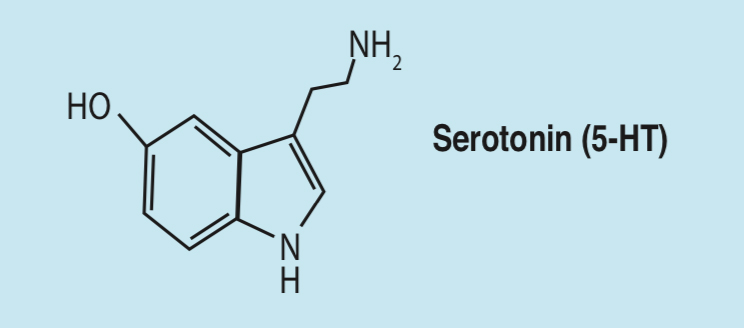A lot! This is true in humans and across nature because the neurotransmitter serotonin is found in almost all animals and plants.
People usually think of serotonin in the context of mood and behavior, and indeed when we feel sad or anxious, serotonin is involved. It’s also involved when humans and other animals eat, learn, fight, mate, exercise, sleep, and wake from sleep. A single neurotransmitter can influence so many diverse processes via its wide distribution in the central nervous system. From cell bodies located at the base of the brain, serotonin-containing neurons send their axons to the far corners of the brain, releasing the transmitter in numerous areas responsible for diverse processes. An array of receptors — distinct proteins on cell surfaces — bind the released serotonin and induce changes in cell actions.
Serotonin has an interesting history. From an evolutionary perspective, it is an ancient molecule, emerging in unicellular organisms at the dawn of life. Receptors that bind serotonin allowing intercellular communication existed more than 700 million years ago, well before the split between vertebrates and invertebrates. Throughout the eras, neural pathways and receptors evolved, leading to many differences in anatomical and molecular structure among animals. Yet even in creatures as diverse as humans, worms, and insects, behavior is modulated by related serotonergic systems, descended from our distant common ancestor.
From a human history perspective, serotonin was first identified chemically in 1949 from tissue lining the stomach (now known to produce more than 90% of the body’s serotonin). Several years later, drugs were found that simultaneously elevated serotonin’s actions in the brain and reduced symptoms of depression. This finding launched an enduring hypothesis central to psychiatry: Depression results when serotonin levels in the brain are too low. Immediately, the search was on to discover drugs able to enhance serotonin’s actions in the brain and, if we judge by the plethora of drugs that have been developed and marketed, the search was successful. Today, the selective serotonin reuptake inhibitors (SSRIs) are the most commonly prescribed treatment for depression, and they’re also widely used to treat numerous other disorders such as anxiety, schizophrenia, alcoholism, impulsivity, and obesity.
While the term “selective” implies specificity to the serotonin system, there is nothing specific about the drugs’ effects in the brain. As noted above, serotonin neurons project very widely, and serotonin receptors are distributed equally widely, residing on millions of neurons containing other neurotransmitters like dopamine, norepinephrine, and acetylcholine. Hence, when an SSRI reaches the brain, it is likely to affect every major neurotransmitter system, leading to a diffuse shake-up of brain physiology. How this shake-up and known molecular actions of drugs translate to clinical improvements in some people (though not all) remains mysterious. Importantly, despite intensive research over six decades, there is little direct evidence that low serotonin activity actually causes depression or other disorders.
What would behavior and emotion be like without serotonin? In humans, we’re not sure, but in mice, genetic engineering has produced animals that possess no brain serotonin at all. Remarkably, these animals live rather normal lives. They show some behavioral effects like increased aggression, but basically their brains function nicely. This has led some researchers to conclude that brain serotonin is involved in everything and essential for nothing. This enigmatic molecule will undoubtedly continue to perplex and challenge future generations of neuroscientists. The next frontier may be understanding teamwork between the microbiome and serotonin-producing cells in the digestive system. While serotonin from the gut cannot directly cross the blood-brain barrier, future research may reveal important serotonergic regulation of gut-brain communication.
Ann Jane Tierney, professor of psychology and neuroscience, has been focusing her recent research on serotonin. Experiments in her lab have examined how serotonin affects aggressive and anxiety-like behavior in several crayfish and insect species.
Do you have a big-picture question for a faculty member? Write to us: magazine@colgate.edu.

